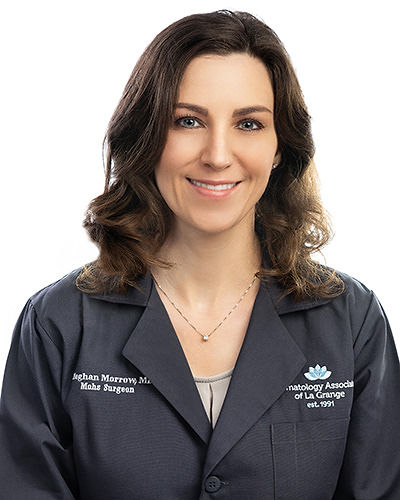Mohs Surgery for the Removal of Skin Cancer
by Dr. Meghan Morrow, MD, FAAD, FACMS

What is Mohs Surgery?
Mohs surgery, short for Mohs micrographic surgery, is a technique for the removal of skin cancers in cosmetically sensitive areas. It allows a detailed microscopic evaluation of all edges of the skin cancer by the Mohs surgeon, ensuring complete removal. By using detailed mapping techniques and complete microscopic control, the Mohs surgeon can pinpoint areas involved with cancer that are otherwise invisible to the naked eye. This results in complete removal of the skin cancer while removing as little normal skin as possible.
How will I know if I’m a candidate for Mohs?
Mohs surgery is primarily used to treat patients with basal cell carcinoma (BCC) and squamous cell carcinoma (SCC) in cosmetically sensitive areas, such as the head, neck, hands/feet, and genitalia. In certain cases, melanoma is treated with Mohs surgery.
How does Mohs differ from other skin cancer removal methods?
Mohs surgery allows us to examine 100% of the peripheral and deep margins, ensuring that the cancer is completely removed. Removing a small margin of normal skin around the cancer allows for less scarring than other methods.
What can I expect the day of surgery?
We perform Mohs at all of our SJH Derm offices. On the day of surgery, we first mark the area the site is confirmed with the patient. Next, the skin is cleansed and numbing medication is injected. After the area is numbed, the visible cancer will be removed by the surgeon. This usually only takes a few minutes. A temporary bandage is placed over the area and the patient will then return to the waiting room while the tissue is processed. Tissue processing and mapping often takes 1-2 hours. If the surgeon sees cancerous cells under the microscope, the entire process is repeated. Once the surgeon is certain that the entire tumor is removed, she will discuss with you what kind of reconstructive surgery, if any, is necessary. We may choose to (1) let the wound heal by itself, (2) repair the wound with stitches, or (3) close the wound with a skin graft or flap. This decision is based on the safest method that will provide the best cosmetic result. Once all surgery is completed, a bandage will be applied and wound care instructions will be provided. Follow-up appointments for wound checks or suture removal can be scheduled before the patient leaves the office.
Though it doesn’t always take a full day, patients should prepare to be in the office for the entire day regardless.
What are the risks associated with Mohs surgery?
The risks are similar to the risks with other skin surgery procedures and include bleeding, pain, infection, bruising, swelling, and scarring.
Can the skin cancer come back?
Cure rates for Mohs Surgery are 98% and higher, which is significantly better than the rates for standard excision or another other accepted method of skin cancer treatment. For Mohs patients, full-body skin examinations are usually recommended every 6 months to monitor for recurrence or the development of new skin cancers elsewhere.
It’s important to stay on top of your regular full body skin exams in order to detect skin cancer early. Early detection is key!
To learn more about Dr. Meghan Morrow, click here.

